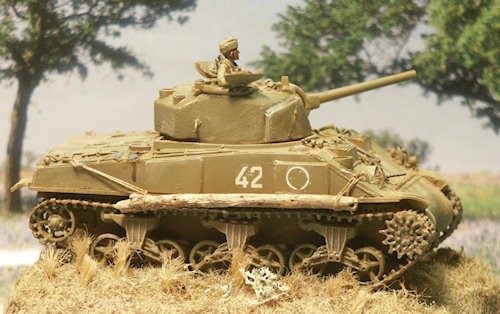INTRODUCTION
This kit is a
conversion kit designed to be used with the lower hull
and suspension of the ESCI - Italeri M4A1 kit. I
think could be used with the Trumpeter, Dragon and UM M4
kits as well; in fact I think a Trumpeter M4 lower hull
may be the better option.
This 1/72 scale
kit represents a mid-WW2 diesel engine Sherman.
Based on the square, welded driver’s hoods
protruding from the 57 degree angled glacis plate this is
a Sherman produced by Fisher Company. Fisher was
the only Sherman manufacturer to produce and use this
type of hood and it is commonly referred to as the “fabricated”
hood. Other producers used cast driver’s
hoods until introduction of the 47-degree glacis. I
have never seen applique armor fitted to the fabricated
hoods as was common to the cast hoods.
This M4A2
variant was used by US Marines on Tarawa, by the Poles in
Italy, by UK forces, and by the Soviets. For an
in-the-box review and photo of all the kit parts I refer
you to:
http://www.onthewaymodels.com/reviews/MrModels/M4A2USMCprev.htm
Many of the
assessments of this particular conversion kit should also
reflect other 1/72-scale Sherman kits offered by MR
Modellbau
Assembly Instructions
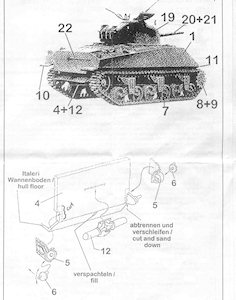
The instruction sheet has one small photo
of an M4A2 Sherman with part numbers and line going to
where the parts go; unfortunately the resin parts in the
kit are not numbered on the pore plugs or parts.
This photo shows the T49 type tracks.
Missing from the kit but visible in this
photo is the sheetmetal exhaust deflector on the rear
just under the muffler (part 12). This deflector
can be made with some sheet aluminum, such as that from
an old pie pan.
The lower line drawing shows modification
of the resin lower rear armor plate and attachment of the
muffler (part 12) and the idler wheel axles and brackets
(parts 5 & 6). Be aware that parts 5 have a
left and right so don’t mistakenly mount them
reversed and upside down. I recommend not
installing the muffler till after the upper hull is
attached to the lower hull. If we substitute a
Trumpeter or Dragon lower hull then we do not have to be
concerned with this step, except for the muffler.
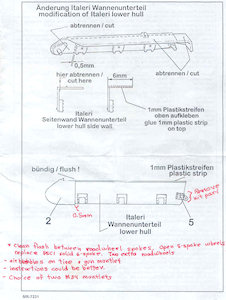
This is another page of MR’s
instructions (with my own notes) on converting the ESCI
lower hull to fit with the MR upper hull part.
Measure carefully and use a small T-square to insure cuts
are at a right angle. This is an easy step to make
mistakes on. Again, if we use a Trumpeter kit’s
lower hull we need not worry about this.
The Parts
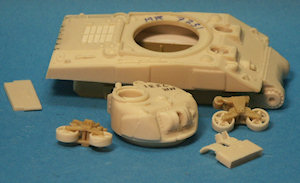
Here is a photo of some of the larger
parts in the MR kit. The MR kit is a mix of cast
resin and cast white metal parts with a turned aluminum
gun barrel.
On the hull the cast intermediate-type,
one-piece differential (a.k.a. final drive or
transmission) cover has been affixed to the hull.
There are applique armor plates on the starboard side
indicating it is not an initial production M4A2.
Detail of the MR Models small-hatch M4A2 hull and turret
appear excellent: with accurate molded on lifting rings,
fabricated antenna bracket on the glacis and cast rear
turret splash guard introduced in 1943. I think the
rooftop exhaust vents are better done on the Dragon
Sherman though. The weld seams look excellent.
The turret appears to be a low bustle
style designated D50878 (based on my reference) produced
in the summer and autumn of 1943. It is without the
loader’s hatch, and features welded-on applique
armor on the right cheek, the narrow M34 mantlet and gun
mount, and the hole for the smoke mortar requested for UK
Shermans and later adopted in US Shermans.
MR provides open 5-spoke roadwheels and
idlers for use with the ESCI bogies; the roadwheel tires
appear too thin to me and are one of the few problems I
found with the kit.
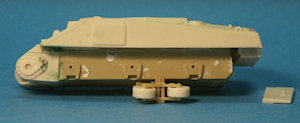
Here is a view of the port side with the
plastic ESCI – Italeri lower hull assembly
attached. The differential cover is a tad
askew and I believe I should have done better. It
is very important that when cutting off the front of the
ESCI hull side you have to get the cut in the exact
position and straight so it fits true and in the right
position with MR’s cast resin differential; this is
where I had problems. Along with fabricating a new
sponson floor, mistakes can lead to bogies in the wrong
location, that are too low or high, or canted in or out.
Something I did not notice at this point
in assembly is that this MR resin hull is warped; the
bottom of the sponson is curved up on both ends!
Oye!
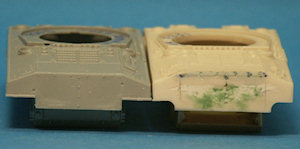
This a comparison photo with the DML kit
of a Fisher produced M4A2(75) kit. The biggest
anomaly we see is the curve of the MR rear plate as it
progresses up and under the sponson. I have no idea
where MR got this from, it is not in their M4A2(76) kit
and I have never seen it on an actual M4 tank; it should
be a right angle as with the DML kit at left.
The sponson side of the MR kit also looks
too tall compared to the DML hull and to scale drawings.
Green putty has been used on the MR rear
plate to smooth it out after cutting off the large pour
plug. The MR rear plate has had holes marked out
and drilled for a series of six horizontal bolts and four
vertical bolts missing from the MR hull.
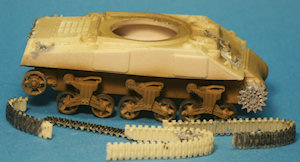
This photo shows the bogies and other
wheels attached, pre-painted in acrylic olive drab paint
and ready for the tracks. The MR early type fancy
sprocket wheel (Parts 8 & 9), cast in white metal,
supplied with the MR resin tracks is used. The
later simple sprocket would be just as valid.
Rather than use the stiff polyethylene
band tracks that came with my old ESCI kit I opted for
the resin MR aftermarket tracks (set MR-7261) which
represent all-steel T-49 type M4 track, a type common to
UK and Soviet Shermans. After cutting the resin
track lengths from their pore blocks and clean-up with a
small file they were dipped in very hot water and bent to
fit around the sprocket and idler wheels. It was a
real race to bend the tracks into the correct shape
before they quickly cooled and hardened.
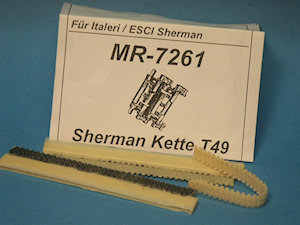
The MR resin tracks are molded well and
reasonably easy to cut off the pore blocks. The
guide teeth are a little small in size and many were
broken off. When bending the tracks and gluing them
to the wheels be sure to orient the broken teeth and
end-connectors on the inside edge where they can’t
be seen.
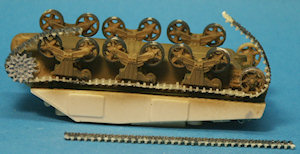
My approach was to glue on the curved
sections around the idler and sprocket wheels and then
splice in the horizontal sections of track in the
gaps. Much of the track is prepainted in acrylic
gunmetal color.
The roadwheels are pre-painted dark gray
and then the areas to get glue are sanded free of
paint. The fit of the MR resin track into the
sprocket teeth was very good.
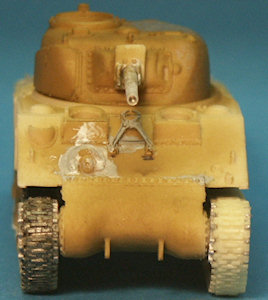 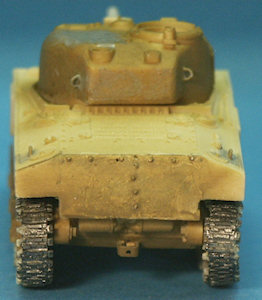
A front view at left shows a slight inward
cant to the tracks on the right, the port side; my fault
in assembling the lower hull: learn from my
mistakes! Don’t look too closely there are
some other mistakes to correct!
This M4A2 is to represent an early
production Soviet Emcha that had the gun travel
lock or cradle between the hoods. After rough
handling needed to get the tracks on the small delicate
parts and the etched brass parts will now be added.
In the view of the rear at right we can
see that the curved angle where the sponson bottom meets
the lower hull side has been squared off a bit but now we
see that the sponson floor is not molded truly
horizontal, it slopes down; the sponson floor does not
meet the hull side at a right angle. This appears
to be a casting problem and not present on another MR
Sherman kit I have. I hope the rear fenders (part
10) will mask this problem?
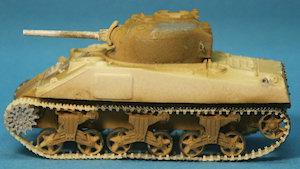
This port-side view shows the tracks
affixed to the suspension. It looks like the
sprocket is mounted a little higher than the top of the
bogies, not good.
There is too much sag in the lower rear in
front of the idler wheel, this is due to the difficulty
in bending the track in the correct position before the
resin track cooled and stiffened. Remember, the M4 Medium
tank, as well as the M3 Medium and M3 Light tanks) all
used “live” track which enjoyed little
noticeable track sag. Some missing track teeth will
need to be replaced just behind the sprocket wheel.
At this stage in assembly, when it was too
late to sand flat, I noticed that the sponson bottom is
curved up at both ends, bulged out on the bottom, we can
see it in the photo, this is not photo distortion.
The engine deck and hull top is not visibly distorted so
I am surmising this defect is because of improper resin
curing? Alas, at this stage there is not much I can
do to fix it!
The tires on the MR Modellbau roadwheels
appear too thin to me, not as well rendered as the same
roadwheel type in the Mirage M3 and Dragon M4 kits.
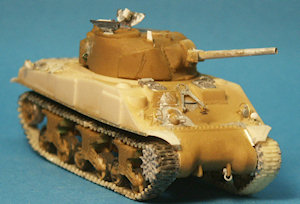
The white-metal driver’s hatches have
been installed shut since their undersides are not
detailed. Small fender braces have been added and
etched brass headlight brush guards.
In this photo the curved sponson bottom is
very evident; the etched-brass strip only accentuates the
curve. This curve, distortion was not present in
the hull of my MR M4A2(76) resin kit.
The commander’s hatch is made up of
etched brass parts from a brass fret for the Revell
M4A1(76) kit. The hatch is actually a little too
thin.
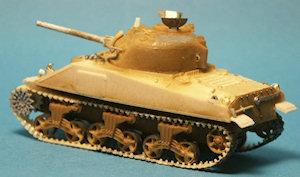
Here’s a good view of the bolt detail
added to the rear hull plate. The bad angle where
the sponson floor does not meet the hull side at a right
angle has been masked by the rear fenders.
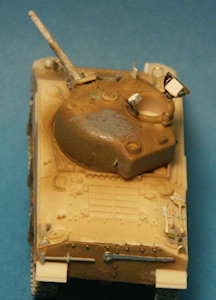
An overhead view of the tank rear prior to
painting and weathering. On the right side are some
etched brass tools such as shovel and axe. Normally
I would not use them because they are much to flat and
thin but with the major defect of the hull distortion I
won’t be entering it into any contests. I have
read that often the crews, to prevent them from being
stolen by passing infantry, often removed these tools.
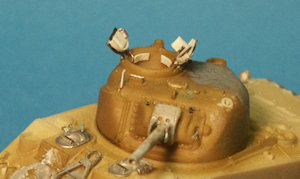
Close-up view of the MR turret. For
changes: a sighting vein was added in front of the
commander’s cupola, a coaxial machine gun barrel,
and lifting rings on the gun mount. The smoke bomb
ejector hole right of the gun was not present on this
early turret so will be filled in.
The MR cupola has no interior detail, and
the etched brass split-hatch I used is pretty Spartan
also so lots of small detail parts like the hatch lip,
periscope, handles, and cushioning pads were
scratchbuilt.
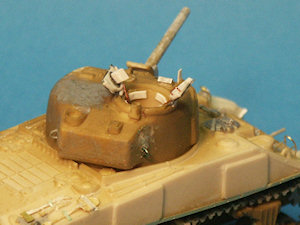
From the rear we see a different views of
the turret and hatch details. Note the strips of leather
cusions around the inside rim of the cupola. It is
when we are detailing things like the open hatch when
great resources like the book M4A2 Sherman, Part 1,
Armor Photogallery #11 really help.
A minor detail is the low mounting of the
rear lifting rings on the turret.
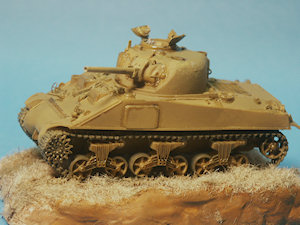
Skipping a step or two the M4A2 has been
given an initial base coat of olive drab acrylic paint,
given a point wash of artists oil in turpentine, and then
mounted on a base representing a grassy knoll.
(Yes, the tall grass can hide some of the poor track
detail and missing guide teeth).
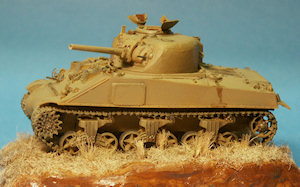
A coat of olive drab, lighter than the
initial coat has been spayed, blending in the dark wash
around the recesses. The underside of the open
commander’s hatch is the same color as the tank
exterior and the pad on the underside of the hatch
painted in brown leather.
An acrylic gloss coat has been applied
around the turret side in preparation for some Soviet
decal markings.
A brown stain representing a diesel spill
flows down the side from the drainhole up on engine deck.

The completed model. After a spray
of clear flat coat the M4A2 was highlighted with
Tamiya Weathering Master, and dusted with paint
pigment powder. The dull coat is mixed with a flat
tan paint to help mute, tone down, the colors and
markings on the model. A graphite pencil was gently
rubbed over the machine gun barrels, track cleats, the
75-mm gun muzzle and on expected wear spots on the paint
like hatch edges.
Logs for un-ditching the tank have been
hung from each side to try and mask the curved distortion
of the hull side, or at least distract from it.
Honestly I have seen many Soviet tanks with logs lashed
to the vehicle but never with an un-ditching logs hung
this way. Another thing I do not like is that the
MR resin tracks look too thin, in addition to being hard
to work with.
I like the looks of the weld beads in
addition to the overall other excellent detail on the MR
Sherman tanks. The weld beads are perhaps over
exaggerated a little but that is fine with me.
The background is simply a photograph I
propped up behind the photo.
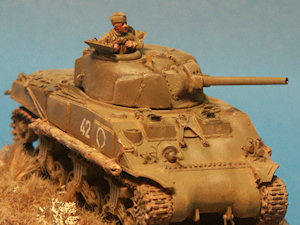
In this photo I’ve played with the
color and tone of the photo giving the Sherman a more
olive drab color. The red-brown pigment powder and
lighter hightlighting is well evident here.
The dark periscope lenses are replicated
with pieces of dark camera film attached with white glue.
The figure is a white metal Soviet tanker
from AB Models cut in half to fit in the
hatch. While some AB figures are very well rendered
this one did not have well done facial features. I
only use them in hatches as the AB figures I have tend to
be short in the legs and look dwarfish to me.
Markings were scraped together from extra
decals and represent an Emcha from the Soviet 2nd Tank
Army unit near Smolensk, inspired from a photo in and
information in the book Comrade Emcha, Red Army
Shermans of WW2.
Though this small-hatch early Sherman
variant has the applique armor plates on the hull sides
and turret it does not have the additional armor plate in
front of the driver’s hoods like many other
small-hatch Shermans. In the many photos I’ve
studies I have never seen a Sherman with the fabricated
(welded) hoods have the extra armor plates. I could
be wrong but only the cast steel hoods seem to only have
the extra armor plates. The welded, fabricated
hoods were only used by Fisher Company.
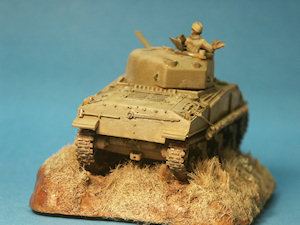
Rear of the completed model. This
M4A2 does not have the sheet metal exhaust deflector like
other (later production?) M4A2’s did.
This is a good view of the steel bar tread
pattern of MR’s T-49 type Sherman track. I
have seen this track on many Soviet Shermans.
Conclusions
1) The Fisher Company produced M4A2’s
used by the US Marines on the island of Tarawa in
November 1943 did not have the applique armor but did
have the later wide M34A1 gun mount. To make a
Marine M4A2 we’ll have to sand off the applique
armor plates and replace the M34 gun mount then take an
M34A1 gun mount from another kit.
2) The conversion kit is a
good kit with some of the best detail that I would
recommend for the intermediate and advanced
modeler. There are some molding defects in the hull
that I have not seen in other MR Sherman kits I have.
3) The MR resin tracks are
challenging to work with but other than T49 tracks
included in a few Dragon kits, these are the only T49
Sherman tracks available that I know of.
4) With the release of a
plethora of new1/72-scale Sherman kits by the likes of
DML, UM, Trumpeter, HAT and Italeri, etc., I am curious
as to the future of more expensive resin Sherman kits
such as this?
5) Though this resin
conversion kit is supposed to be mated with the
1/72-scale Italeri/ESCI plastic Sherman kit, it should
work with other plastic kits. My favorite to mate
with an MR resin Sherman is a Trumpeter Sherman lower
hull and suspension. The small fittings like
headlights and tools are pretty crude in the ESCI Sherman
so for a good display model it is best to acquire some
from a DML Sherman kit.
References
Tank Battles
of the Pacific War, by Steven Zaloga, Concord
Publications Co., (1995). ISBN 962-361-607-4.
This softcover book covers combat and vehicles used by US
and Japanese forces.
Comrade
Emcha, Red Army Shermans of WW2, by Claude Gillono
with Leife Hulbert, The Oliver Publishing Group
(2011). ISBN 978-0-9806593-7-5
M4A2
Sherman, Part 1, by Wojciech J. Gawrych, Armor
Photogallery #11.
Sherman
Minutia website This is the best on-line
reference for the details of the Sherman tank variants;
not as much of vehicle combat history though.
http://the.shadock.free.fr/sherman_minutia/index.html
Modeling the
Sherman in 1/72 Scale website. Doug Chaltry’s
excellent website on the Sherman tank.
Back to M4A2 Kit List
Back to Table of Contents
|
